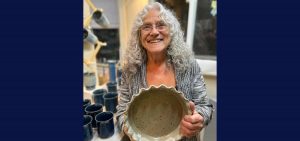Culture
2024 Ohio Arts Council Heritage Fellowship recipient Susan Abramovitz reflects on decades of dedication to her craft
By: Emily Votaw
Posted on:
SHADE, Ohio (WOUB) – In the early ’70s, Susan Abramovitz and her father built a pottery wheel in the basement of their Youngstown home, following instructions from Mother Earth News magazine. She had no idea at the time how profoundly pottery would shape the course of her life.
Over 50 years later, her dedication to the craft earned her recognition as one of the Ohio Arts Council’s 2024 Heritage Fellows. The OAC gave her this award at the 2024 Ohio Paw Paw Festival. Coincidentally, the Paw Paw Festival is sponsored by Mother Earth News magazine.
According to the Ohio Arts Council’s website, Heritage Fellowships are granted to “Ohio folk and traditional artists who are the finest and most influential masters of their particular art forms and traditions.” Few arts are more “traditional” than pottery—humans have been making ceramics for longer than just about anything else.

The development of ceramics played a key role in our species’ ability to preserve food, marking a significant shift towards an understanding of a future beyond the immediate. Throughout thousands of years, this ability to plan and envision the future evolved from simply surviving the night to creating vast cities and complex forms of written and spoken communication.
The profoundly human and historical nature of pottery has long been part of what appeals to Abramovitz about the discipline. She has always been interested in making what the OAC calls “functional pottery”—items like mugs and casserole dishes, which she says allow her to “make inroads into people’s lives in tiny but meaningful ways.”
Abramovitz grew up in the ’70s and says this played no small role in her decision to professionally pursue this particular kind of pottery. She was part of a larger cultural movement that rejected sleek, mass-produced goods.
Instead, she recalls, “Everybody my age wanted a handmade mug or a handmade plate.”
“There were […] a lot of people who liked what we were doing—that we were making things by hand, that we weren’t buying plastics, that we weren’t part of the machine,” Abramovitz says. “And so I had a built-in audience.”
Initially fueled by that built-in audience, Abramovitz’s practice of the craft took her to many places, including a position as head of the ceramics department at Case Western Reserve University in Cleveland. However, the most significant part of her career has been spent running Rock Riffle Run Pottery, which she established in 1978.
Over the decades, Abramovitz has accomplished a lot. She developed a unique stoneware clay body using raw materials found in Southeast Ohio; played a key role in preserving a stoneware clay known as ‘Goldart,’ which was nearly decimated due to contamination from sulfur and iron; and has supported countless aspiring potters by freely sharing her knowledge of the craft.
Now in her 70s, Abramovitz moves quickly and easily around her studio. She credits her profession for this, at least in part.
“One of the good things about pottery is it’s extremely physical,” she says. “It makes me really tired, and it’s hard, but I think the benefits outweigh the difficulties.”
It hasn’t always been easy. In fact, it rarely has been. Abramovitz says she feels that her career trajectory would be nearly impossible in the present and that support for the craft, although still present, has dwindled over time. Though receiving recognition has never been the focus of her work, she says that receiving a Heritage Fellowship from the OAC was still deeply meaningful.
Just as her dedication to the craft has shaped her life trajectory, so too have her hands shaped countless pieces of pottery—and, in turn, those pots have found homes, one mug and one dish at a time, in the hands of people who value the personal warmth of something handmade.
“What I do, (…) it’s not like some giant sculpture that will be out in public spaces where millions of people will see it,” says Abramovitz. “This is about the coffee mug that you’re drinking out of.”

